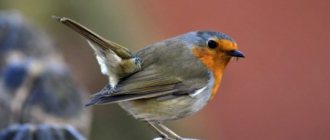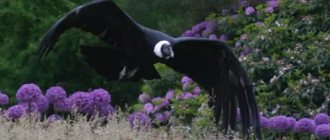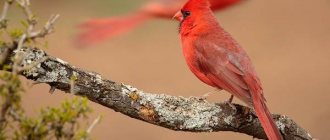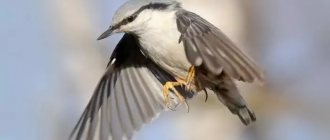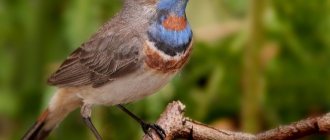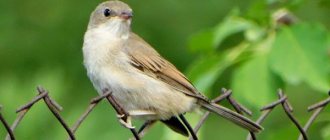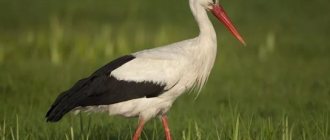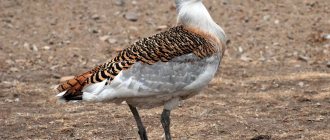- Wild animals
- >>
- Birds
The handsome finch is a widespread forest dweller. Since ancient times, its bright feathers served as a talisman for the family; they brought happiness and comfort to the house. The finch is not only handsome, but also sings excellently, producing its ringing and melodic trills, in no way inferior to those of a nightingale. It will be interesting to study his lifestyle, character, habits and many other features.
Description of the bird
The finch is a genus of songbirds of the finch family, the order of passeriformes, the average body length is 15 cm, the wingspan is up to 28 cm, the weight reaches 30-40 g.
What does it look like
This is what a finch bird looks like in the photo
- Advertisement -
Finches are bright, elegant birds. The color of the plumage is dominated by brown, blue, gray, white, and green shades. In autumn and winter, the color of finches is dull, while during the mating season they literally “bloom”. Finches have a strong beak and a long tail, and powerful wings. The paws are thin, long, and four-toed.
Why is it called that?
The photo shows a finch in flight.
It’s not hard to guess why the finch was called a chaffinch. This cute bird can't stand the cold. In late autumn, you can see how he sits with a ruffled head, hiding his head in lush feathers. He seems to be chilly and freezing. In some regions you can hear other nicknames for this bird - “chaffinch”, “brambling”, “cast iron”, “snegirik”. The female is usually called a "chaffinch" or "finch".
Male and female: differences
The image shows a male and female finch
– Advertisement –
Sexual dimorphism is manifested only in plumage color. Females are usually not as elegant as males.
Male
The photo shows a male finch.
Male finches have a black forehead and a blue (smoky gray) cap and scarf. The back is brown, the belly is painted fawn. The lower back and edges of the feathers give off an emerald tint. The black wings have a bright transverse white stripe. During the mating season, the male's beak is silvery-bluish. In autumn and winter, the same as that of the female - yellowish-brown.
Female
Finch (female).
Photo: S.M. Chuprov Female chaffinches are not so colorful. The main color of the feather is brownish-gray, with a dark back and whitened belly. A dark brown stripe stretches from the beak to the collar area. The wings are darker than the body. The thick brown color is “diluted” by white wedges, which are also present on the edges of the tail.
How does this finch then cross the Sahara and the seas?
With difficulties.
There is a place on its migration route where it needs to fly for 40-48 hours without stopping. Perhaps it would be more logical to fly around such complex areas along a long trajectory, but for this it would be necessary to greatly complicate the navigation unit, increase the brain, consumption and add a bunch of other things, which is quite difficult to do on a platform weighing 21.4 grams. The crow has been upgraded. Crows never fly into a trap (more precisely, they turn around in time, if something happens); they are too smart for such simple tricks. But the crow is much heavier.
Correct holding of a bird: turn it upside down to cause a system error (a bird usually never does this in life) and hold the head between your fingers. If you now inflate the belly fluff, you will see the amount of fat right through the skin. And this is no longer a finch, but a robin. We don’t know who it is by gender, because in robins sexual dimorphism is not perceived by the eye by primates.
Lifestyle
The photo shows a finch bird in winter
Migratory bird or not
Finches are migratory birds , although there are species that prefer to winter in inhabited areas, where the climate is suitable for wintering. The finches are removed from their place when the first frosts occur (in mid-October). Some birds fly to Central Europe, some to the south, to the Mediterranean. Some species wait out the cold Russian winter in the foothill forests of the Caucasus. Those who live in Siberia and the Urals in the summer move to Kazakhstan and Central Asia for the winter.
The photo shows finches sitting on wires
Finches migrate in flocks of 1000 individuals each. They fly at speeds of up to 55 kilometers per hour. To rest and eat, they descend to the ground every 5-6. Birds return home from late February to April. The males arrive first, and after a week the females return.
What does it eat?
The photo shows a finch feeding on a caterpillar.
The finch feeds on insects and plants. In summer, finches “lean” on food of animal origin. The beak of this bird is strong, durable, capable of splitting both the shell of a beetle and the hard surface of an acorn. Finches happily eat caterpillars, ants, bugs, flies, larvae, bugs and weevils.
The plant-based diet includes:
- weed seeds (nettle, quinoa);
- coniferous tree seeds;
- flowers;
- buds of deciduous trees;
- foliage;
- cones;
- fruits and berries.
Finches look for food on the ground. The finch hunts for its prey with fast and frequent steps, catching up with “lunch” in a few fractions of a second.
When and in what month do finches arrive in spring?
- Despite the fact that finches fly away as soon as they feel the first serious frost, they fly home in early spring.
- Finches arrive to us in mid-February.
- Some of them arrive a little later - in March. And it even happens that finches arrive in April, but, as a rule, they always return home even when the ground is covered with snow.
They arrive when there is still snow
Males always return first and females arrive only 1-2 weeks after them.
Life of finches
A nest built by a finch.
Photo: S.M. Chuprov As soon as warm, sunny weather sets in outside, the finches begin to arrange their homes. Only females do the housework. At the end of April - beginning of May, finches begin to build nests. Finches make their houses on the branches of deciduous or coniferous trees. On birch, cedar or poplar, the nest is built on the side branches, close to the trunk. If they are going to live on pine needles, then, on the contrary, they build a nest on the edge of the branch, away from the center.
The photo shows a female finch near the nest
Dwellings are located at a height of two meters. Finches do not like dense places, because during the period of feeding the chicks, females often have to go down to the ground in search of worms, and in a thinned forest it is easier to find food.
finch nest
The photo shows where the finches build their nests.
The finches' homes are voluminous and durable. They can reach 20-30 centimeters in diameter. The nest is made in the form of a bowl - wide at the edges and narrowed at the bottom. The frame of the bird's house is made of strong material - birch bark, bark, dry twigs and moss. To prevent the walls from falling apart from the wind and the vigorous activity of the finch chicks, they are “tightened” with cobwebs. The wall thickness is up to three centimeters. To camouflage their homes, birds use light lichen or birch bark. A soft bedding is placed at the bottom of the female, which will warm the tiny testicles.
How did he even get caught?
Our hero is a migratory bird. Actually, he flew into a huge net made of fishing nets during his flight. Like this:
He most likely mistook the net itself for cleverly formed vegetation, something like a strange grove with interlocking crowns. And he tried to fly out, moving forward. During migration, birds generally stomp +W in the direction of the target more often.
And the Curonian Spit is located exactly in the direction of migration. The trap works like a fishing net, snatching from the flow of birds all those who statistically fly into the 35 x 15 meter target.
Reproduction of finches
Finches are allowed to have "polygamy". That is, having fertilized one female, the finch can mate with another. During mating games, fights are common between males - everyone wants to get one or another female. The mating process takes place on thick branches or the ground.
The photo shows the eggs of a finch bird
One female lays 4-7 eggs. The photo shows how the finch’s eggs are tiny (up to 1.5 centimeters in diameter), colored bluish-green or yellowish-red with pink streaks. Only the female incubates the offspring. She does not leave the nest even to eat. But at this time the caring husband carries worms and larvae to his wife.
The photo shows finch chicks in the nest
Finches breed within two weeks. In early June, tiny chicks are born. The wrinkled skin of young finches is red, with sparse light down. Newborns squeak funny and are already trying to whistle. From this moment on, both parents are involved in caring for the offspring. Finches feed their chicks with animal food - insects and larvae. Now the male has no time for trills, because he needs to feed the kids, who, by the way, are constantly hungry. By two weeks of life, the chicks fly on their wings to make their first flight.
In the photo, a male finch feeds its chicks - photo
Males are scrupulous about their paternity. They protect the home and notify if a predator appears nearby. In addition, males help feed even other people's chicks.
The photo shows a chick finch
Finches lay their second clutch at the end of summer. This time there are fewer eggs - 3-4. The female incubates her second offspring in the new nest.
Is it true that a finch screams like a cat when in danger?
Each bird, sensing danger, begins to make certain warning sounds. They warn not only the object of danger about the finch’s mood, but also all his comrades who are nearby that they should be wary.
- demonstratively expresses strong anxiety with a sharp, loud and repetitive sound with a wide range of frequencies. In these birds, such signals most often resemble “kicks”. The finch must make all such sounds loudly , obviously so that the enemy can see it and stop pursuing it.
Finches squeak loudly
- However, sometimes the finch does not want to stand out too much from the background of other birds and demonstrate its excitement. In this case, he makes sounds of hidden alarm. Most often they look like a long, very, very thin whistle that begins and ends almost silently. The finch usually gives such a signal once in order to help its comrades and warn them of possible danger, but at the same time not to give away itself and its location.
When in danger, a finch does not make sounds like a cat, it does not scream like a cat and, in principle, does not know how to imitate this animal.
Enemies
Large birds - magpies, crows, woodpeckers, jays - feed on finches. At night, owls pounce on a family of finches. They often attack nests, eating not only the female, but also her brood.
But not only birds love to feast on these cute birds. Don't mind trying birds and squirrels, martens, stoats and even cats. Because of such an abundance of enemies, forest finches have a hard life. The average lifespan of a bird is only 2-3 years.
In captivity, finches live much longer: if comfortable living conditions are maintained, a house finch can live up to 12 years.
Who hunts finches, what diseases do birds suffer from?
Finch eggs and chicks are a delicacy for crows, squirrels, cats, stoats and weasels. In late spring, clutches suffer less from predators; they are protected by vegetation, making it difficult to find nests.
Adult finches are hunted by owls and hawks. If the birds notice an owl, they give a signal that mobilizes the flock. Together they drive the predator away from the nests. When a hawk approaches, an alarm is sounded and the finches hide among the leaves and branches.
Finches develop tumors on their feet and legs caused by the Fringilla coelebs papillomavirus. Papillomas range in size from a small nodule on a finger to a large tumor affecting the foot and paw. The disease is rare. Out of 25,000 finches, only 330 suffer from papillomas.
Spreading
Arel
Habitat of finches
These agile birds live everywhere - in Europe, Western Asia and even North Africa. In Russia, the finch is considered the most common bird.
Habitats
The photo shows a finch on a coniferous tree.
Finches choose mixed forests and undergrowth as their habitat. But they don’t shy away from people either - families of finches can be found in city parks, squares, and some even manage to build nests under the roof of human homes.
The photo shows a finch in a deciduous forest
In the wild, finches nest in sparse mature stands, at least two meters from the ground. During the cool season, they prefer thickets along rivers and lakes.
Lifestyle and habitat
The finch bird lives in deciduous, mixed, and coniferous forests. Does not like the deep taiga, where it is difficult to find food on the ground. Preference is given to sparse light forests and artificial plantings with mature trees and a cool microclimate. Often found in park areas, country houses and garden plots.
Many are sure that the finch is a migratory bird . It depends on the place of settlement. Flocks that have chosen central Russia and Siberia in winter go to the Mediterranean coast, to the floodplains of Central Asia. Some flocks reach the Canary, British Isles, North Africa, represented by Morocco, Tunisia, Algeria.
If finches initially settled in the southern regions, they lead a sedentary lifestyle or migrate short distances to neighboring regions without crossing the country’s borders.
Before departure, the birds gather in flocks of up to one hundred individuals. They fly fast -50–55 km/hour. For rest and food, they make long stops in the territories of small settlements, where they can refresh themselves. The flight is spread out over time and occurs in waves, but the bulk of the birds go to warmer climes in September. The flocks are heterogeneous; finches often join them.
They return to their permanent nesting sites from the end of February to the end of April. The further south the area is located, the earlier the birds appear. The males arrive first; their arrival is determined by their loud mating songs. The females arrive a week later.
The decline in the number of the species is affected by the deterioration of the ecological situation. From year to year, the area of deforestation increases, and the amount of agricultural land and forest plantations treated with pesticides does not decrease. Adverse weather conditions play a negative role.
Birds have many natural enemies, including squirrels, stoats, and large birds (magpie, jay, crow, woodpecker). During the nesting period, they destroy clutches and small chicks. The bird behaves carelessly while singing.
Carried away by roulades, the male finch raises and throws his head back, neither seeing nor hearing anything around him.
Finches spend the main part of the daylight hours sitting on a branch, slowly moving sideways along it, or jumping along the ground, looking for food. They fly at high speed and in waves.
During the mating and nesting period they create pairs, the rest of the time they stay in flocks. Thanks to their endurance, unpretentiousness and quick adaptation to their environment, finches are common in Europe. Their number reaches 95 million pairs.
The finch's singing encourages some people to keep the birds in captivity. If you have no experience, then it is better to choose another species that is easily tamed. Some individuals become attached to the owner, but for the most part the birds remain wild until death.
To adapt, the finch is placed in a spacious enclosure or a small cage covered with soft fabric. Having transplanted it into a permanent home, they cover it with a light-colored cloth, since when a person approaches, the bird hits the bars violently and does not calm down for a long time.
To hear the song, the male is kept alone, without a pair. In the presence of a person, the bird sings only when he is motionless. The dwelling is equipped with a bathhouse and perches. Place low containers with seedlings of spruce or pine.
The finch is fed canary seed, mealworms, ant eggs, meat and cereals. Hemp seed is allowed, but in limited quantities, since food with a high oil content leads to eye disease and abscesses.
Kinds
There are several hundred species of finches. They differ in size, color, and habitat. Five of them are common in Eurasia. We have given 5 types of finch: photos and descriptions.
European finch
Pictured is a European finch
- Latin name: Fringilla coelebs coelebs
- Weight: 30 g
- Highest classification: Finches
- Conservation status: Least Concern
The European finch is widespread in Russia, the CIS countries, Western Europe and the Middle East. The length of its body is 16 centimeters, the length of its tail is 9-10 centimeters. There are more than 10 tones in the European color.
Caucasian finch
- Latin name: Fringilla coelebs solomkoi
- Weight: 30-35g
- Highest classification: Finches
- Conservation status: Least Concern
In the Caucasus, Transcaucasia, Crimea and northern Iran, finches are common, which differ from European ones in their strong and long beak - the length reaches 1.5 centimeters. Such a beak is needed in order to get living creatures out of thin holes in rocks and gorges. The body length of the Caucasian finch reaches 13 centimeters.
The Caucasian finch (also known as the Crimean finch) cannot sing as beautifully as representatives of the European subgroup. His song sounds more like a wild cry than a song.
Blue finch
- Latin name: Fringilla teydea
- Size: 16-18 cm
- Highest classification: Finches
- Conservation status: The species is endangered
Blue finch - distributed only on the island of Tenerife and Gran Canaria. Habitat: pine forests. Slang name "Blue Finch".
Hyrcanian Finch
- Latin name: Fringilla coelebs alexandrovi
- Weight: 20-25 g
- Highest classification: Finches
- Conservation status: Least Concern
Small population of gray finches. The head and neck are painted dark gray, the back is dark chestnut. The lower part of the body is light. Hyrcanian finches are small, weighing 20-25 grams. They live in the mountains and rare forests of the Iranian province.
Kopetdag finch
- Latin name: Fringilla coelebs transcaspia
- Weight: 30-40 g
- Highest classification: Finches
- Conservation status: Least Concern
This species of finches is pale in color. The main tone is fawn, with a lot of white on the wings and tail. For this feature they are also called white finches. These birds live in countries in Turkmenistan. The Copert Dag finch belongs to the subspecies of the Hyrcanian finch.
reel
In the photo there is a finch bird
- Latin name: Fringilla montifringilla
- Weight: 35-40 g
- Highest classification: Finches
- Conservation status: Least Concern
The head, back, long tail feathers, and flight wings are painted blue-black. The abdomen, middle wing coverts, loin, rump are white. The black and white canvas is diluted with reddish inclusions along the edges of the feathers.
The finch's beak is black with a light yellow base.
Female finches are predominantly gray.
Black finches are large, with a strong beak and well-developed wings. Finches live in Russia, as well as Scandinavia, Finland and the former countries of the USSR. They fly to North Africa and Asia for the winter.
Appearance and features of the finch bird
The finch belongs to the finch family; on average, the body size of this bird is no more than 15-20 cm, and its weight is up to 40 g. But if it does not stand out for its special size, you need to pay attention to its color. Usually their color is very dim, expressed in brown, gray, white and blue.
The lower part of the body and cheeks are brown, and the neck and crown of the head are gray-blue, the spot above the beak and the wings are black. There are also elongated white spots on the wings, so a photo of a finch can fascinate absolutely anyone.
Females and chicks have rather dull plumage, their feathers being mostly grey-brown. The back of the female is dark, and the abdomen is light brown; the wings, although black, also have white edges.
This description of the finch bird is suitable for the most common species, the European one, however, this species is not the only one of its kind.
Keeping at home
The photo shows a finch on a hand.
Finches are kept as pets. However, this bird is difficult to control. The finch cannot be tamed. Accustomed to freedom, the bird behaves restlessly in a cage. The pet refuses to eat and hits the bars. Often the imprisonment ends in illness and death of the bird, which is not accustomed to the cramped conditions of the cage.
The photo shows a finch at home
To make the finch comfortable, the cage for it is made spacious. Poles are installed in the finch's cage so that it can jump from “branch to branch.” A drinking bowl and food containers are placed on the floor. It is important to change the water on time and remove uneaten food, otherwise the finch will get an intestinal infection.
The photo shows a female finch in a cage
Yes, and there are many difficulties with nutrition. In captivity, finches are fed eggs, bone meal, cottage cheese, nuts, fruits and vegetables. And also animal food - worms and bugs brought from the garden.
The photo shows a male finch in a cage
House finches sing, unfortunately, rarely. Living in a cage, the bird is in a depressed, nervous state, which interferes with the normal performance of songs.
Keeping a finch in a cage is not a very wise decision. These birds are not adapted to life in captivity.
How do finches care for their young?
Finches are very caring parents; they do not leave their chicks, feed them and protect them from predators.
- After the appearance of small cubs, the female begins to leave her house in search of food for both herself and the children. But now taking care of them is not only the job of mom, but also of dad. The male also brings food to the chicks.
- It is worth noting that the chicks are constantly asking to eat, so adult finches are always in search of plant and animal food for the children (mostly animal).
Chicks
Male finches feed not only their own children, but also other people's chicks. They are always on guard, looking out for enemies, and when they see danger, they immediately give alarm signals to warn other parents about the possible danger.
- After another 2 weeks, the little chicks make their first flight; as a rule, the parents are in the nest or near it at this time.
Interesting Facts
The photo shows a finch bird in flight
- There are 450 species of finches in the wild.
- In winter, finches lead a gregarious lifestyle. Sometimes you can see sparrows in their families.
- Folk omens indicate that the louder the finch's trill, the faster the first frost will come.
- The female finch is hardworking. During the period of nest construction, she descends to the ground about 1.5 thousand times in search of building material.
- In captivity, finches suffer from obesity and eye problems.
- By eating weevils, finches provide all possible assistance to summer residents in the fight against these insect pests.
- Finches are active only during the daytime.
- Birds move along the surface in short lateral jumps.
What's happening
The finch marks itself with a ring. He was caught by cunning ornithologists at the Fringilla field station of the Rybachy biological station in the Kaliningrad region on the Curonian Spit on Earth. All evolution has led to the fact that, on the one hand, a finch has formed, which has flown into a trap, and on the other, an ornithologist has appeared who wants to record its mass, gender, estimate the amount of fat, measure the length of the wing and hand it an aluminum ring with a number. Either a radio transmitter or a satellite transmitter. But right now it's just the ring.
Singing
The photo shows a singing finch.
Finches sing in the spring, with the onset of the mating season. Their singing is a flowing multi-minute roulades. Concerts are organized by the males: they sit on elevated surfaces, throw their heads back and begin to sing, surrendering to the moment without reserve. The trills of finches are solemn, joyful, and rolling.
The photo shows how the finch sings
The chaffinch begins to sing with quiet whistling sounds - the bird seems to be singing before a performance. Then comes the second part - the trill itself, which lasts 2-3 seconds. The performance ends with a short sharp sound (stroke). After 7-10 seconds the song repeats again. Only adult males use this style of singing. First-year children sing less talentedly, without breaking the song into the three described parts. Their trill is smooth, with less intonation. By the way, females also sing throughout their lives.
In the photo the finch is singing
Males learn the technique of species singing through onomatopoeia of adults. In the repertoire of singing masters there are up to 10 variants of specific songs. They have a different chorus or trill melody. When singing in a group, the flock sings 2-3 versions of songs.
What sounds do finches make: do they squeak, squeak, or sing?
Finches are amazing birds; their singing vaguely resembles the singing of a nightingale. It is worth saying that finches are capable of making a variety of sounds; they can squeak, squeak and, of course, sing. Moreover, their songs are very melodic, original and sonorous.
- Birds begin to sing in the spring, when their mating season begins. It is worth saying that males sing loudly and loudly, this is how they attract their females. Females, like small chicks, sing less attractively, not so loudly, ringingly and solemnly.
- The finch's song begins with very quiet, calm whistling - this is the first stage of the song, a kind of chant.
Finch trill
- Next we hear the most beautiful trill ; it does not last long, literally a few seconds.
- The bird ends its song with a very short but sharp sound, which is called a stroke.
- Finches also know how to “sip” - make sounds similar to a drawn-out “rrrrryu”.
- Almost every male can sing 5-10 different songs.
- If a whole flock of finches sings, you can hear several versions of songs at once.
FOOD
The finch is primarily a plant-eating bird. Its food consists of only one quarter animal food and three quarters plant food, mainly from various seeds. Herbivory is a characteristic feature of all finches. With the help of a strong beak, an uneven palate and strong facial muscles, the finch copes with even very hard food. It breaks beetle shells and seed shells equally easily. The finch's menu includes seeds of weeds and coniferous trees, green buds of leaves and flowers, wild berries and rowan.
So what, the bird stomps forward in a straight line?
No.
The young bird follows a rather complex route, vaguely similar to how an airplane moves using radio drives, that is, from landmark to landmark. The next year, the bird begins to “cut corners,” that is, it understands exactly how it can save time and effort by flying shorter in some places.
If there is an obstacle along the way (desert or water), the bird tries to fly around its edge. If it’s too far along the edge, it tries to pass directly, like the Sahara.
Birds return exactly to the place where they were born, usually nesting not very far from their home (analysis of the distribution of nests of birds that nested for the first time). Not very far - it could be 20 meters, 50 meters, 200 meters, etc. Most likely, it is enough to deliver the bird within a radius of 50 to 300 kilometers from home, then it will orient itself cognitively. It has been numerically proven that birds tend to nest near their birthplace.
The expansion of the species' range is being done at the expense of young birds: teenagers are more prone to change, and can climb to places where adults would not fly if they were sober. For example, a Mediterranean warbler (a southern bird, common in France) was caught at the station several years ago, and a white stork is now nesting in the Leningrad region. This is a species that moves clearly to the north, northeast, expanding its range. There were at least 4 cases of flamingos flying in. True, flamingos in Kaliningrad hardly survived.
But the principles of bird navigation on the road are still a mystery. Most likely, there are many factors here: magnetic organs, following other birds, learning from elders through landmarks, and so on. You can even just simply focus on the flow: many birds send “I’m here” packets, simply screaming from time to time, which gives the understanding that they are somewhere there and that it is safe to fly there. These are, for example, blackbirds. But night migrants, like the same robins, fly not in a school, but singly. It has been proven that birds study the position of the North Star or other stars. Perhaps they also use other principles that we actively use to deliver nuclear warheads throughout the planet - we also started with navigation by the stars (well described in Chertok’s book), and end with inertia in combination with other parameters.
It is now believed that birds primarily use magnetic navigation for long distances, plus they remember the path, plus they are guided by other birds, plus they know stopover regions, houses and goals. More precisely, the use of magnetic information for orientation is confirmed by numerous facts, while the use of the Earth’s magnetic field for navigation is only one of several hypotheses that has not yet received unambiguous confirmation.
The same albatrosses, for example, find their home islands in the last area by smell, which the winds carry over 300-400 kilometers. By the way, guess what exactly by the smell. In general, there is a rather complex model of a heap of input data, which no one has yet thoroughly understood.
How does a bird know where to fly?
Very briefly and roughly the situation seems to be this: when a bird is born, it records the coordinates of its home. We are talking about the parameters of the magnetic field, for example. Then she has two devices for magnetic navigation: one in the beak, and the second is connected to the eye and cuts into the trigeminal nerve. We know almost nothing about both, for example, the metal in the beak, which everyone thought, turned out to be an accumulation of macrophages that eat it, and not a sensor. But something is mixed into the visual signal, and something else goes to the brain. How the bird sees this is unclear, but choose what you like best:
Or like this. Nobody knows how she sees:
And what happens when the bird has to go?
When you need to start migrating, that same arrow appears in the field of view (I’m exaggerating, perhaps these are stripes in an undesirable direction or a decrease in the sharpness of vision in an unnecessary direction, etc.) - in general, a pointer appears to the place where the bird needs .
Before that, according to the timing, she had acquired the right feathers, stored fat - and now the endocrine system gave her hormones that simply leave no doubt that she NEEDS TO FASTER, but she has to fly THERE. Therefore, even when a bird is placed in a cage, it will try to jump in this cage (exhibit its locomotor activity) in the direction given to it by its genetic program. These are stereotypical locomotor acts. If you start giving it food, the bird’s firmware will decide that it has flown to an area rich in food (that is, if you give it a lot of food), and the number of such jumps will sharply decrease, and the bird will move on to the mass gain step. Then, having “refueled”, she will again begin to strive further towards the goal of the journey, that is, she will again begin to actively jump in the cage. The fattest birds fly out first, having accumulated less fat - if possible, they delay the flight in order to have time to stock up on fuel.
“An analysis of starts carried out on birds with different fat reserves showed that birds with a large amount of fat took off earlier, since they could fly more at night on their reserves, while leaner birds could fly less. At the same time, both skinny and fat people “plan” to land at approximately the same time - in the pre-dawn twilight.”
How can you see it all for yourself?
Go to the Kaliningrad region and climb the Curonian Spit.
This is a station in the village of Rybachy and a field station in Fringilla. The hospital is named after the finch, Fringílla coélebs, that is, our finch, which lives here in assortment. The main building is in the village of Rybachye, and the Fringilla field station is in the middle of the spit, and is easily accessible to tourists and schoolchildren. Excursions are needed to earn money, because the first ornithological station in our country is financed approximately only by the salaries of scientists. True, they relied on scientific publications and grants at the right time, and learned to take these very grants quite well - long before they were pleased with budget cuts. It was founded by the German pastor Johannes Thienemann in 1901, and in 1956 it was relaunched as a Soviet station. More precisely, a biological station was organized here, because it studied not only birds, but also parasites, and in the 60s they also worked with fish.
By the way, when I talked about “the world’s oldest ornithological station,” I got into a noble holivar. The fact is that the Rybachy biological station was founded in 1956, and its first director, Lev Osipovich Belopolsky, headed it. But before that there was the Vogelwarte Rossitten station, which was truly the world's first German ornithological station (founded in 1901). The word “Vogelwarte” itself appeared thanks to the German bird lover, artist Goethke, who in 1893 wrote the book “Vogelwarte Helgoland”, but “Vogelwarte Helgoland” (still exists) appeared only 10 years after Rossitten, in 1910. That is why Rossitten station is considered the oldest. But Helgoland employees emphasize that the Rossitten station ceased to exist in 1944, and in 1956 the Soviet Rybachy station began operating on the Curonian Spit.
But what is important to us is that at the time the station was founded there was no forest nearby, there was a section of dunes overgrown with willow bushes. Foresters planted the forest. There is a long struggle with sand here, when sections of the dune are forced into special baskets where trees can grow. Later they form a forest, which changes the landscape of the spit. So gradually the sand recedes.
Our pastor saw a beautiful flight of birds in the fall and decided that this was where they needed to be caught and counted. Giant traps appeared in 57. This is where logs with accumulated data are published.
Well, now you can roughly imagine how awesome the main() function is in birds. Periods of different activities that are adjusted by environmental parameters, endocrine regulation for motivation to do what is necessary, a magnetic organ with output to the optic stream, another magnetic organ, a bunch of other features. In general, a very beautiful example of a perfectly optimized winder exactly for the platform.
With us today was Candidate of Biological Sciences Andrei Mukhin, director of the station.
Since endocrine regulation is being studied, does that mean blood is taken from birds?
It’s true, they take it from some people.
This makes it possible to assess corticosterone levels, for example. Analyzes at the station Of course, it would be possible to sequence their genome and establish family ties, but this requires a little more captured birds and a little more expensive equipment, so for now only hormones. If they win the grant, something similar will happen.
Is migration ongoing?
If we are talking about a long-distance flight to South Africa, for example, then no, because the bird simply does not have that much power reserve.
There are times when she needs to sleep and rest - these are short stops, usually less than one day (more precisely, they stop during the day anyway, because they move at night). And there are times when she stops for 3-4 days to eat and gain weight. They can stay longer, up to 10 days. On the Curonian Spit, the places are not the most suitable for catching insects and searching for plant seeds, so finches do not stop for more than a few hours. By the way, finches collect insects to feed their chicks, but during migration they collect seeds.
But in the same lower reaches of the Volga near the Astrakhan Biosphere Reserve or somewhere near Volgograd they may well get stuck for a week. That is why, if a shopping center with a parking lot and a couple of villages nearby are built near the migration stopover sites, birds will begin to die in Africa, and in Finland, and in Kaliningrad. This is ecology.
Is there another way to watch the bird?
Yes, you can give her a transmitter. The lightest beeper is 0.7 grams (custom ones are 0.2 grams, and the smallest factory one not used at the station is now 0.25 grams), the search radius of a stationary directional antenna is 4-5 kilometers in the air. Lighter ones only give a maximum of 2 kilometers. For larger birds there are up to 20 kilometers, and for the healthiest predators such as storks (although formally they are not predators, they are capable of eating a hare on occasion), there are satellite transmitters. Which made it possible to discover one awesome thing, about the fact that birds know how to cut corners during migration. But more about that a little later. If you are interested, the most famous case in RuNet is Sanka, who had a great migration, flying to the Astrakhan Nature Reserve for fish (here is my post about this transfer point, by the way), eating on the Euphrates, and then stopping on the banks of the Nile.
In the village of Rybachy
There are two such tracking stations with antennas on the Curonian Spit, one at the Fringilla field station, at the 23rd kilometer of the Curonian Spit, the second on the territory of the Rybachy biological station, at the 34th kilometer of the spit. That is, there are 11 kilometers between them.
The sectors look away from the tower, creating, in fact, two lines on the spit (more precisely, cones of the radiation pattern), at the intersection of which you can track the bird. This is for those very light beepers.
How did we know that it even works like that?
They took the bird, put it in an analogue of a Faraday cage (more precisely, in a system of magnetic rings), took it to another place and looked where it flew.
Repeated several hundred times with a control group. Then they took the bird, put it in a device that allows you to emulate a different magnetic field (from another point on the Earth), something like fakeGPS, and put it on a plate with chalk. Where the bird jumps most often is considered the direction of its flight. This is how these cones are made, coated with chalk:
But after such a path, far from all sources of radiation, there are already experimental birds:
“In our experiments, we mainly study magnetic reception. And for this we use magnetic rings, with the help of which we can change different parameters of the magnetic field. We can rotate the needle of a magnetic compass by a certain degree. We can simulate the magnetic field at any point on Earth. Thus, we can, as it were, virtually transfer an animal from this point to another point, changing only the magnetic field. For us biologists, there are two types of rings. One system is Helmholtz rings, the other is the Merritt system. They differ mostly in the number of rings in each axis. That is, in the Helmholtz system these are two rings in the axis, x, y and z. And in the Merritt system there are four of them. The more rings, the more stable and larger the volume of space that creates a homogeneous magnetic field. If we take, for example, a Helmholtz ring and a Merritt ring of the same diameter, two meters, then inside the Merritt rings the volume of a homogeneous magnetic field will be one meter per meter, that is, such a cube. And for Helmholtz rings it will be 60x60x60 centimeters" Alexander Pakhomov
